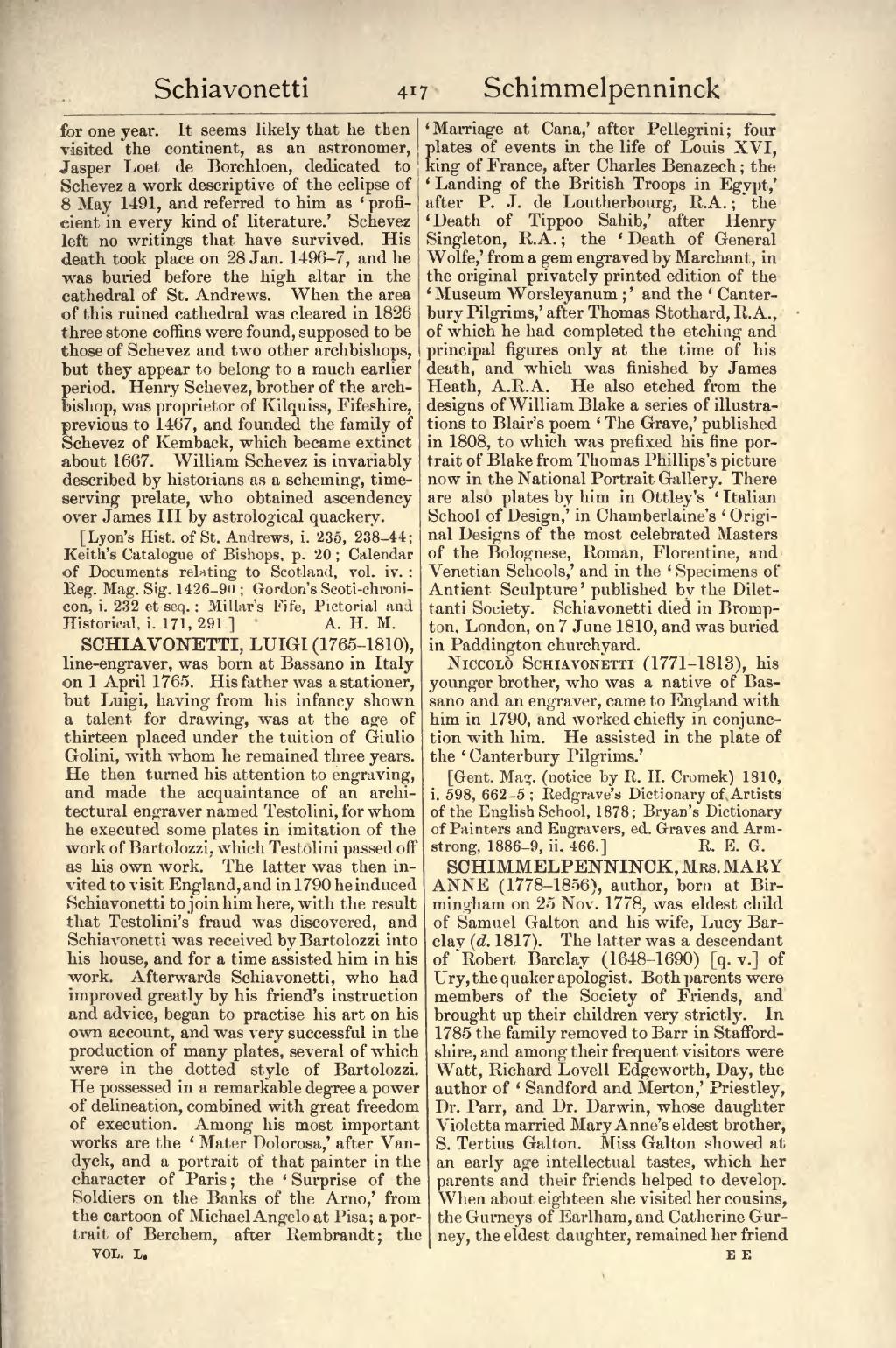for one year. It seems likely that he then visited the continent, as an astronomer, Jasper Loet de Borchloen, dedicated to Schevez a work descriptive of the eclipse of 8 May 1491, and referred to him as ‘proficient in every kind of literature.’ Schevez left no writings that have survived. His death took place on 28 Jan. 1496–7, and he was buried before the high altar in the cathedral of St. Andrews. When the area of this ruined cathedral was cleared in 1826 three stone coffins were found, supposed to be those of Schevez and two other archbishops, but they appear to belong to a much earlier period. Henry Schevez, brother of the archbishop, was proprietor of Kilquiss, Fifeshire, previous to 1467, and founded the family of Schevez of Kemback, which became extinct about 1667. William Schevez is invariably described by historians as a scheming, time-serving prelate, who obtained ascendency over James III by astrological quackery.
[Lyon's Hist. of St. Andrews, i. 235, 238–44; Keith's Catalogue of Bishops, p. 20; Calendar of Documents relating to Scotland, vol. iv.; Reg. Mag. Sig. 1426–90; Gordon's Scoti-chronicon, i. 232 et seq.; Millar's Fife, Pictorial and Historical, i. 171, 291.]
SCHIAVONETTI, LUIGI (1765–1810), line-engraver, was born at Bassano in Italy on 1 April 1765. His father was a stationer, but Luigi, having from his infancy shown a talent for drawing, was at the age of thirteen placed under the tuition of Giulio Golini, with whom he remained three years. He then turned his attention to engraving, and made the acquaintance of an architectural engraver named Testolini, for whom he executed some plates in imitation of the work of Bartolozzi, which Testolini passed off as his own work. The latter was then invited to visit England, and in 1790 he induced Schiavonetti to join him here, with the result that Testolini's fraud was discovered, and Schiavonetti was received by Bartolozzi into his house, and for a time assisted him in his work. Afterwards Schiavonetti, who had improved greatly by his friend's instruction and advice, began to practise his art on his own account, and was very successful in the production of many plates, several of which were in the dotted style of Bartolozzi. He possessed in a remarkable degree a power of delineation, combined with great freedom of execution. Among his most important works are the ‘Mater Dolorosa,’ after Vandyck, and a portrait of that painter in the character of Paris; the ‘Surprise of the Soldiers on the Banks of the Arno,’ from the cartoon of Michael Angelo at Pisa; a portrait of Berchem, after Rembrandt; the ‘Marriage at Cana,’ after Pellegrini; four plates of events in the life of Louis XVI, king of France, after Charles Benazech; the ‘Landing of the British Troops in Egypt,’ after P. J. de Loutherbourg, R.A.; the ‘Death of Tippoo Sahib,’ after Henry Singleton, R.A.; the ‘Death of General Wolfe,’ from a gem engraved by Marchant, in the original privately printed edition of the ‘Museum Worsleyanum;’ and the ‘Canterbury Pilgrims,’ after Thomas Stothard, R.A., of which he had completed the etching and principal figures only at the time of his death, and which was finished by James Heath, A.R.A. He also etched from the designs of William Blake a series of illustrations to Blair's poem ‘The Grave,’ published in 1808, to which was prefixed his fine portrait of Blake from Thomas Phillips's picture now in the National Portrait Gallery. There are also plates by him in Ottley's ‘Italian School of Design,’ in Chamberlaine's ‘Original Designs of the most celebrated Masters of the Bolognese, Roman, Florentine, and Venetian Schools,’ and in the ‘Specimens of Antient Sculpture’ published by the Dilettanti Society. Schiavonetti died in Brompton, London, on 7 June 1810, and was buried in Paddington churchyard.
Niccolò Schiavonetti (1771–1813), his younger brother, who was a native of Bassano and an engraver, came to England with him in 1790, and worked chiefly in conjunction with him. He assisted in the plate of the ‘Canterbury Pilgrims.’
[Gent. Mag. (notice by R. H. Cromek) 1810, i. 598, 662–5; Redgrave's Dictionary of Artists of the English School, 1878; Bryan's Dictionary of Painters and Engravers, ed. Graves and Armstrong, 1886–9, ii. 466.]
SCHIMMELPENNINCK, Mrs. MARY ANNE (1778–1856), author, born at Birmingham on 25 Nov. 1778, was eldest child of Samuel Galton and his wife, Lucy Barclay (d. 1817). The latter was a descendant of Robert Barclay (1648–1690) [q. v.] of Ury, the quaker apologist. Both parents were members of the Society of Friends, and brought up their children very strictly. In 1785 the family removed to Barr in Staffordshire, and among their frequent visitors were Watt, Richard Lovell Edgeworth, Day, the author of ‘Sandford and Merton,’ Priestley, Dr. Parr, and Dr. Darwin, whose daughter Violetta married Mary Anne's eldest brother, S. Tertius Galton. Miss Galton showed at an early age intellectual tastes, which her parents and their friends helped to develop. When about eighteen she visited her cousins, the Gurneys of Earlham, and Catherine Gurney, the eldest daughter, remained her friend
